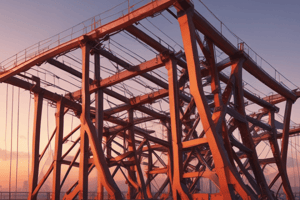Podcast
Questions and Answers
What type of load is responsible for causing an oblique fracture pattern in the tibia?
What type of load is responsible for causing an oblique fracture pattern in the tibia?
- Tension (correct)
- Shear
- Torsion
- Compression
In what type of loads do the muscles around the hip joint cause a bending force?
In what type of loads do the muscles around the hip joint cause a bending force?
- Torsion
- Bending (correct)
- Compression
- Shear
What is the role of the glute med in reducing injury risk at the hip joint?
What is the role of the glute med in reducing injury risk at the hip joint?
- Increases compression forces
- Increases tension
- Increases bending force
- Decreases compression forces (correct)
Which type of deformation results in positive strain in a material?
Which type of deformation results in positive strain in a material?
What does stress represent in relation to external loads on a material?
What does stress represent in relation to external loads on a material?
How does immobilization affect vertebrae in terms of load capacity?
How does immobilization affect vertebrae in terms of load capacity?
What does the symbol O represent in stress analysis?
What does the symbol O represent in stress analysis?
Which property is dimensionless and has no units due to its nature?
Which property is dimensionless and has no units due to its nature?
In healthy vertebrae, what is the approximate value of Poisson's ratio?
In healthy vertebrae, what is the approximate value of Poisson's ratio?
What does the yield point signify in stress-strain curves?
What does the yield point signify in stress-strain curves?
What characteristic differentiates a pliant material from a stiff material?
What characteristic differentiates a pliant material from a stiff material?
What property describes the continuous deformation of a viscoelastic material under constant load?
What property describes the continuous deformation of a viscoelastic material under constant load?
Study Notes
Types of Load
- Compression: occurs when a force is applied inward, resulting in a decrease in size or volume
- Tension: occurs when a force is applied outward, resulting in an increase in size or volume
- Shear: occurs when a force is applied parallel to a surface, causing deformation
- Torsion: occurs when a force is applied to twist an object
- Bending: occurs when a force is applied to flex an object, resulting in a change in shape
Load Examples
- Tibia fracture: can occur due to bending load, resulting in an oblique fracture pattern
- Hip joint: subject to combined loads, including compression, bending, and torsion
- Glute med: important for neutralizing compression forces and increasing tension in the hip joint
Stress and Strain
- Stress: the internal resistance to external loads, measured as force per unit area (σ = F/A)
- Strain: measures how much a material changes in response to a load, can be positive (increased length) or negative (decreased length)
- Load-deformation curve: a graphical representation of stress and strain, used to analyze material behavior
Stress and Strain Notations
- σ (sigma) denotes compressive or tensile stress
- τ (tau) denotes tangential (shear) stress
Linear Strain and Poisson's Ratio
- Linear strain: occurs when strain is measured in one direction
- Poisson's ratio: a dimensionless value that measures strain in two directions, typically around 0.22 in healthy vertebrae
Material Properties
- Strength: the ability to resist applied stresses without failure, dependent on direction and rate of loading
- Linear strain and stress can be assessed using a mechanical testing machine
- Stress-strain curves: used to analyze material behavior and identify properties such as yield point, failure point, and ultimate point
Material Properties (continued)
- Yield point: the elastic limit, beyond which material deformation becomes permanent
- Failure point: the point of no return, beyond which material breaks
- Residual strain: the remaining deformation after removal of the load
- Ultimate point: the maximum level of strain a material can withstand
Stress-Strain Curve Analysis
- Slope: measures elastic modulus and stiffness
- Regions: elastic and plastic regions can be identified on the curve
- Points: yield, ultimate, and failure points can be identified on the curve
- Mechanical energy: the area under the stress curve, measured as 1/2 x stress x strain
Viscoelastic Materials
- Exhibit non-linear stress/strain characteristics and the ability to stretch or shorten over time
- Properties: hysteresis, creep, and stress-relaxation
- Examples: ligaments, tendons, and other biological tissues
Studying That Suits You
Use AI to generate personalized quizzes and flashcards to suit your learning preferences.
Description
Learn about different types of loads such as compression, tension, shear, torsion, and bending. Explore examples like tibia oblique fracture due to bending load and combined loads like the hip joint experiencing compression, bending, and torsion forces.




